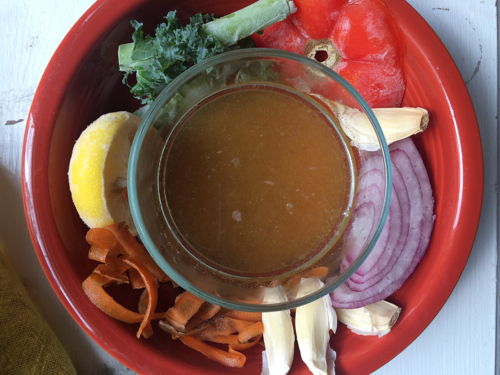
I love Fall. The colors, the cool breezes and the sweaters made me shiver with delight. But with the change of seasons come allergies and the threat of the flu.
History records Hippocrates as saying that health begins in the gut, and my recovery from depression using a nutritional overhaul indicates that there may be truth to his words. Making your own bone broth may boost your immune system because it can help heal the lining of the GI tract. It is cheaper and far healthier than any chicken or vegetable broth you can buy. Here are the easy steps to creating this superfood.
Recipe: Homemade Bone Broth
Author: Lauren White
Preparation
1. As you prepare vegetables for cooking during the week, save the scraps in the freezer. Scraps would include carrot peelings, garlic and onion skins and ends, and the white inner parts of peppers. (You can use squeezed lemon halves as well; some of the bitterness of the rind will enter your broth when you make it, so experiment with how many to use. I put in 2-3 halves.) We wait to make broth until we have at least 3 quart size freezer bags full of vegetable scraps.
2. Buy a whole chicken. Save the giblets in the freezer and roast the bird in cookware that will catch its juices, such as a Dutch oven. Add the chicken juices to your giblets.
3. When you eat the chicken, use a fork and knife so that you can reserve the bones. We don’t try to save small pieces such as the wing and the neck because they are difficult to eat while keeping the bones clean. Once you have eaten all of the meat, add the bones and chicken carcass to your giblets and juices. Store in the freezer until you are ready to make your broth.
Making Your Broth
1. When you are ready to make your broth, defrost your vegetable scraps and chicken for at least an hour so that they are easier to remove from your freezer-safe containers. Place them in a large cooking pot.
2. Add extra carrots, onions, garlic or any other fresh vegetables that you can spare. Add in fresh or dried herbs. We like to use 5-10 bay leaves, a few sprigs of fresh rosemary, a dash of dried basil, a tablespoon or two of dried parsley and a few peppercorns.
3. Add a tablespoon or two of white or apple cider vinegar. The vinegar will help the healthy gelatin to be released from the chicken bones and organs.
4. Fill the rest of your pot with filtered water. Bring to a slow boil, then cover and lower the heat. Watch your pot so that it does not bubble over when it begins to boil; I can’t tell you how many times I’ve had to clean chicken and vegetable juice off of my stovetop! Simmer for as long as you can. The longer you simmer, the more nutrients will flow from the scraps into the broth. I usually simmer for about 8 hours.
5. When you are finished, turn off the heat and let your broth cool for at least an hour. Don’t be afraid of the gelatinous skin that forms on the top of your broth after it cools. That’s a sign that all the good fats and collagen from your chicken scraps made it in! Add salt to taste. Strain the broth and store in the fridge. The chicken and vegetable scraps can be composted. I like to separate my cooled broth into mason jars and keep them in the freezer.
Use your bone broth in rice, quinoa, and any recipe that calls for chicken broth or bouillon. When I make rice and quinoa, I like to uses a 1:1 ratio of broth to water; it creates a nice texture and flavor. Bone broth is also good heated up and drunk from a mug, especially during cold and flu season.
Homemade bone broth is a pantry staple in our house year-round, but it’s especially helpful as the days get darker and colder. Enjoy this simple, frugal and natural food.
Disclaimer: I am not a doctor. These statements have not been evaluated by the Food and Drug Administration and are not intended to diagnose, treat, cure or prevent any disease. The stories and information provided at eastofthelake is to be used solely at your own risk. Before making changes to your diet, activities or lifestyle, consult your healthcare provider.
